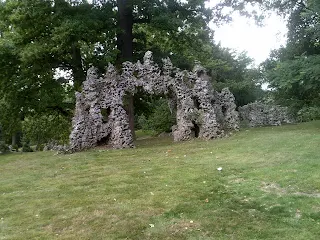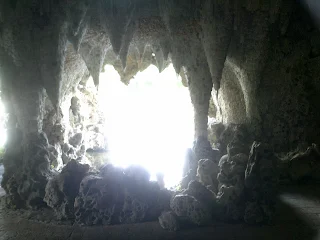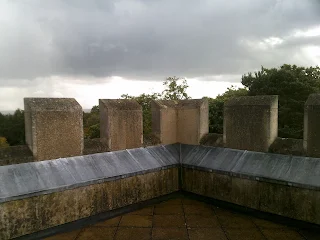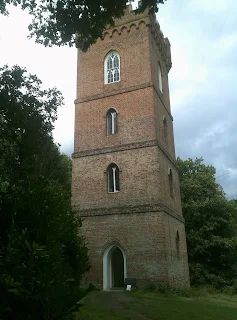Painshill is a park in Surrey, and I've wanted to visit it ever since a Facebook friend posted details and pictures, but it's a pain in the butt to get to from London, involving two trains to Waterloo, then one or two- depending on the day of the week- trains onwards to Cobham & Stoke d' Arbenon station then a bus or taxi. It managed to earn itself the nickname 'Pain In The Arse Park' from me!
So, when my cousin Edwina, who lives in Cheam, mentioned that it's not far from where she lives, and that her husband/chauffeur would be willing to take us there as long as I got to Cheam, then I jumped at the chance. I'm glad I did as it's a truly magical place, and that's impressive praise coming from straight-talking moi. I'm not one for giving out gushing compliments but this place was so lovely that I'm planning a return visit with my SuperDean.
History: Painshill was created by aristocrat Charles Hamilton and is a collection of follies, designed to delight. He began to acquire land at Painshill in 1738 and his vision was to create 'living paintings' in a new style of magical garden- see, I was bang on in using the 'M' word to describe this place! It took 35 years for Hamilton to design and create these nonpareil gardens, and many of the Grade 1 listed follies have since been rebuilt or refurbished.
Here is my pictorial account of our day.
This is the bridge into the gardens...
Statue of Bacchus.
The Gothic Temple, high up on the hill.
Gothic Temple.
The temple floor, with the view of the Five Arch Bridge in the background. I couldn't stand on the temple floor as some sort of refurbishment work (painting, I think) had just taken place.
Here is the back of the Ruined Abbey- the front is much more impressive, but that's for later...
Chinese Bridge.
Grotto Island. The grotto is made of limestone and reminds me of impacted skulls.
View over the lake.
Grotto entrance.
And now we come to the piece de resistance of the park. The inside of the Crystal Grotto is an entirely man-made creation and the mysterious passages and the main chamber are lined with calcite, gypsum, quartz, fluorite and other minerals and stones.
Dazzling stalactites have been created...
The grotto chamber was stunning and my photos really do not do it justice...
View through a hole...
The Turkish Tent, viewed from the grotto.
My favourite grotto hole picture.
Walkway.
'Skull' ring.
Leaving the grotto. This grotto is in no way grotty!
Grotto exit.
Gothic Temple in the distance, taken from Grotto Island.
Woollett Bridge.
Mausoleum.
Five Arch Bridge.
View of the Turkish Tent.
Cascade.
Waterwheel.
I didn't get a very good view of the Waterwheel- so here's a cheeky PDF for you to feast your minces upon.
Hermitage. Apparently a man was paid a goodly sum of money to stay here for seven years- but he was sacked three weeks into his tenure when he was found drinking at a nearby inn! I don't blame him! I like solitude, but having to live like this for seven years? No thanks.
View from the Hermitage.
Hermit's bed.
We then progressed to the Gothic Tower, getting caught in a slight shower, but it was nothing to cry about. You can get views out of the windows, like these...
And from the battlements, like these...
Ye olde electricity pylons! Apparently, you can see the London skyline on a good day. This wasn't a good day!
Battlements.
The Gothic Tower.
I popped up the tower to take pictures whilst Edwina sat and had coffee and cake in the tower cafe (by the way, the triple layer sponge was delicious!) and, when I came down, she'd obviously pulled a man as I was told that we would be getting a lift back with one of the park rangers, in his golf buggy!
Thank you, Del-Boy for saving our legs and taking us to see places we probably wouldn't have seen, not possessing the knowledge that he has. It meant that some of our views were fleeting, and we missed out on visiting the Ice House, but I thoroughly enjoyed our ride back.
Here are the Vineyards. The wine produced from them can be bought in the shop.
Del-Boy took us back to the Gothic Temple. It sure as hell beat climbing up the hill!
We saw swans and cygnets, ducks and drakes, a heron and a deer. On our drive back, we caught a view of the front of the Ruined Abbey. We drove past quite quickly, so I didn't get a chance to photograph it, so here's a PDF.
As we speak, I'm setting a date for a return visit, as I really want to show my SuperDean this park. It's not expensive- only £8 for an adult- and the guide book is a snip, at £1.50.
The ambience of Painshill is beautiful and it really is somewhere special.







































































